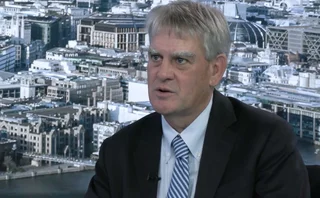
Data house of the year: Thomson Reuters
Energy Risk Awards 2018: Thomson Reuters delivers data and analysis tailored to clients’ specific needs through its investment in data infrastructure and strategic partnerships
Thomson Reuters stands out for its capacity to manage an enormous range of data, but also to deliver insights through its own data analysis. The firm has a team of 130 analysts globally working across all asset classes, more than half of whom work in the energy space. They crunch data, build models, create supply-and-demand forecasts and analyse the impact of these on prices.
“For Hurricane Harvey for example, we were tracking the paths of the hurricane and looking at where the path might go,” says Leigh Henson, global head of commodities at Thomson Reuters. “Then we were looking at the potential impact of that on say, production, refining, and overall the movement of ships and other transportation of either crude or products. Ultimately, we could see what the impact might be on prices as a result of outages that may occur from Harvey. The thing that caused most impact to the oil markets was the flooding that occurred as a result of Harvey, especially to the refineries.”
The need to diversify business in the energy and commodities markets is creating a widening appetite for information. As firms move into new areas – for example, big oil majors are increasingly looking at investments in renewables – they need new insights on which to make informed decisions and they need to be able to aggregate the data in order to use it meaningfully.
“We are starting to see a pick-up of interest in understanding the benefits of digitalisation, where [firms] can assemble data from various sources, analyse that data and view the resulting insight in order to shed light on where they can operate more efficiently, or provide better insight on trading decisions,” Henson says.
In a sector built on real-world assets – as opposed to the cashflows of financial contracts – firms need to build virtual models of the physical world in order to assess various business scenarios. To do that effectively across global operations, they must tag physical operations in a consistent, uniform way, then create relationships between those different tags. For example, to correctly describe crude streams, refineries, ports, storage and vessels, a firm must be able to link all of those things together.
We are starting to see a pick-up of interest in understanding the benefits of digitalisation, where [firms] can assemble data from various sources, analyse that data and view the resulting insight in order to shed light on where they can operate more efficiently
Leigh Henson, Thomson Reuters
“You can only do that if you have a really good framework and consistent instrumentation scheme for the meta data,” Henson says. “Then you have the ability to link them together through a knowledge graph or data well.”
Thomson Reuters’ larger energy clients face a multitude of risks. They are in a very capital-intensive industry where margins can be thin and quickly eaten up by wrong-way price moves. Prices can be whipsawed around by supply-and-demand fundamentals and geopolitics, and market liquidity can change suddenly on the back of regulation or policy decisions. In addition, there are now more regulatory requirements around client engagement, for example onboarding trading counterparts requires anti-money laundering screening. Every element of these involves data, its capture, aggregation and analysis, often with a need to consolidate that into simple displays that users can engage with.
Thomson Reuters endeavours to take the operational weight from clients by aggregating the right information and delivering it in a way that allows them to take meaningful insights from that pool of data.
“We work with third-party data and bring a lot of that data together into a common framework,” Henson says. “But it’s not just about aggregation, it’s also about normalisation to make sure those data items from different sources actually work together in a manner that makes sense.”
Thomson Reuters has ‘inbound’ and ‘outbound’ partners. The former might be a partner that distributes content through the TR framework, such as Platts, making their benchmarks available through the TR platform. Outbound partners offer systems that manage and analyse Thomson Reuters’ data, for example a trading and risk management platform that includes pricing data.
“Over the years people have told us that there are two things they find more difficult than others,” Henson observes. “One is getting their hands on a reliable set of fundamental production and consumption data. The other is getting some forward-looking analysis [on that data]. We onboard a lot of fundamental data, which we didn’t five years ago. We also consume a lot of that fundamental data ourselves.”
A lot of work is needed to onboard the data properly, organise it in databases and make it available through various different products. Thomson Reuters’ outbound partners then make data available through their platforms, which customers can use alongside Thomson Reuters.
“Enabling clients to make the best use of content, regardless of where it comes from, is one of the core value-adds that we can provide,” Henson says. “In an open world, we are very keen to enable clients to take the pieces that they want to take, and to blend them together with other elements in order to give them the best possible solution.”
Only users who have a paid subscription or are part of a corporate subscription are able to print or copy content.
To access these options, along with all other subscription benefits, please contact info@risk.net or view our subscription options here: http://subscriptions.risk.net/subscribe
You are currently unable to print this content. Please contact info@risk.net to find out more.
You are currently unable to copy this content. Please contact info@risk.net to find out more.
Copyright Infopro Digital Limited. All rights reserved.
As outlined in our terms and conditions, https://www.infopro-digital.com/terms-and-conditions/subscriptions/ (point 2.4), printing is limited to a single copy.
If you would like to purchase additional rights please email info@risk.net
Copyright Infopro Digital Limited. All rights reserved.
You may share this content using our article tools. As outlined in our terms and conditions, https://www.infopro-digital.com/terms-and-conditions/subscriptions/ (clause 2.4), an Authorised User may only make one copy of the materials for their own personal use. You must also comply with the restrictions in clause 2.5.
If you would like to purchase additional rights please email info@risk.net
More on Awards
Collateral management and optimisation product of the year: CloudMargin
Delivering the modern blueprint for enterprise collateral resilience
Flow market-maker of the year: Citadel Securities
Risk Awards 2026: No financing; no long-dated swaps? “No distractions,” says Esposito
Pricing and analytics: fixed income – Quantifi
Quantifi delivers high-performance, transparent and adaptable pricing and risk analytics for fixed income and credit markets
Derivatives house of the year: Citi
Risk Awards 2026: Rev up, RWAs down, as US bank gets back on track (with added XiNG and XiP)
Technology vendor of the year: SS&C Algorithmics
Risk Awards 2026: From cloud, to chips, to maths tricks – vendor getting more out of existing tech
SS&C Algorithmics: winner’s interview with Curt Burmeister
SS&C Algorithmics wins three categories in this year’s Markets Technology Awards in addition to Technology vendor of the year at the Risk Awards
Best vendor for system support and implementation: Murex
Murex wins Best vendor for system support and implementation at the Markets Technology Awards 2026
Pricing and analytics: cross-asset and structured – Murex
Murex wins Pricing and analytics: cross-asset and structured at the Markets Technology Awards 2026 thanks to its MX.3 platform







